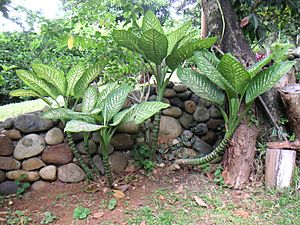Dieffenbachia facts for kids
Quick facts for kids Dieffenbachia |
|
|---|---|
 |
|
| Dieffenbachia bowmannii | |
| Scientific classification | |
| Kingdom: | |
| Division: | |
| Class: | |
| Order: | |
| Family: | |
| Genus: |
Dieffenbachia
|
| Species | |
|
See text. |
|
Dieffenbachia is a group of tropical plants known for their beautiful, patterned leaves. These plants are very popular as houseplants. They can grow well even in shady places inside homes. The name Dieffenbachia honors Ernst Dieffenbach, a German doctor.
Contents
What is Dieffenbachia?
Dieffenbachia plants belong to the Araceae plant family. They are often called "Dumb Cane" or "Leopard Lily." These plants are native to tropical areas of the Americas. They are known for their large, colorful leaves. The leaves often have patterns of green, white, and yellow.
Why is it called Dumb Cane?
The name "Dumb Cane" comes from a special substance in the plant. If someone chews on the plant, this substance can cause a temporary burning feeling. It can also make it hard to speak. This is why it's important to be careful around these plants.
Where Does it Grow?
Dieffenbachia plants naturally grow in the tropical rainforests of the Caribbean, South America, and Central America. In these places, they grow under the shade of taller trees. This is why they do so well indoors. They are used to less direct sunlight.
Growing Dieffenbachia as a Houseplant
Many people love to grow Dieffenbachia plants in their homes. They are easy to care for and add a touch of the tropics. Their big, colorful leaves make them a great decoration. They can grow quite tall, sometimes reaching several feet high.
Light and Water Needs
Dieffenbachia plants like bright, indirect light. Too much direct sun can burn their leaves. They also need regular watering. It's best to let the top part of the soil dry out before watering again. They prefer warm temperatures, like those found in most homes.
Important Safety Tips
It's very important to know that Dieffenbachia plants contain a substance that can irritate skin and mouths. Always handle these plants with care. It's a good idea to wear gloves if you are repotting them. Make sure young children and pets do not chew on the leaves or stems. If contact happens, wash the area with water.
Who was Ernst Dieffenbach?
The plant genus Dieffenbachia was named after Ernst Dieffenbach. He was a German doctor and naturalist. He lived from 1811 to 1855. He explored different parts of the world, including New Zealand. He studied plants and animals during his travels.
Images for kids
See also
 In Spanish: Dieffenbachia para niños
In Spanish: Dieffenbachia para niños







